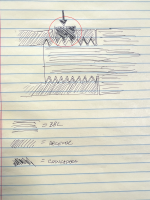Thanks. I do not know what Seekins uses now. At one point they had a bolt rifle with an aluminum receiver that was using a barrel extension to carry the loads much like an AR10.Out of curiosity, do you happen to know which kind the new Seekins rifles use? I hope it's the AI system and not the Curtis.
Thanks for the explanation by the way, it was very good.
I get what you're saying, but with respect, your concept is incorrect here. There's an air gap clearance in the threads, which is why you can screw them together with only running torque. When you bottom the shoulder to the face of the action this closes the air gap on only one side of the thread and opens it further on the other side. The screw closes down the pitch diameter in the localized area and this drives axial load (tension) into the joint because the shoulders are butted against each other.Maybe “point load” isn’t perfect, but with the apposing 60* threads, the mechanism being compressed into the side of the thread is pushing forward on the tenon as it is pulling it back. I do not feel the tenon in an AWMC is loaded in tension due to the locking mechanism.
If there was not a shoulder reference in place then your argument would be valid and it would just be contact friction holding the joint in place.


